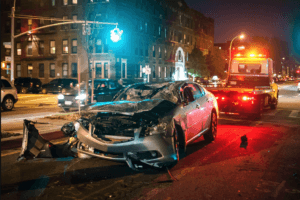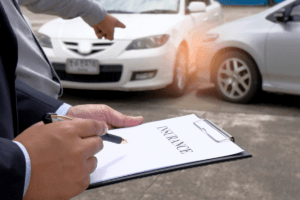
Sometimes, things go smoothly, and liability is obvious. For example, the other driver received a ticket, and the police report lists their actions as the cause of the wreck. If the other party decides to fight their liability, you may need a skilled personal injury attorney to help you understand how fault is determined in a Texas car accident case.
Understanding Contested Car Accidents in Texas
If more than one car is involved in a crash, the parties often debate over who caused the collision and what happened during the accident. Additionally, if three or more vehicles were involved in the accident, determining fault becomes even more complicated. When two or more parties cannot agree on who caused a crash, a car accident case is considered contested.
According to the Texas Department of Insurance, Texas is an at-fault state when it comes to liability for car accidents. This means you are eligible to file a claim against the driver who is found at fault for the crash. They are responsible for paying the costs of your injuries and car accident property damage. If they push back against your claim, it is considered a contested car accident case.
If you aren’t able to negotiate an out-of-court settlement with the insurance company – which will have a much higher chance of success if you work with an experienced personal injury lawyer – you may need to file a personal injury lawsuit with the help of an attorney.
This not only allows you the chance to receive compensation for your medical bills and auto repair, but it also lets you request payment for your pain and suffering, which insurance policies typically don’t cover.
Proving Fault in a Texas Car Accident Case

To prove fault in a Texas car accident case, you must be able to do so by what is called a preponderance of the evidence, which means you need to prove your version is more likely correct than the other party’s. This is done by establishing negligence on the part of the allegedly at-fault driver by showing these four elements:
- The other driver owed you a duty of care to drive safely and avoid accidents.
- They breached their duty of care to you as a fellow driver by engaging in a negligent or reckless action or by failing to act.
- You have injuries and property damage caused by their failure to uphold their duty.
- You have expenses from your damages that must be repaid.
Using Evidence to Prove Negligence
A preponderance of the evidence means that not only is your evidence more convincing, but there is also more of it. You can never have too much good documentation when you are going against insurance companies and defense attorneys for the other driver. When it comes to collecting evidence to show negligence, your car crash attorney may use items such as:
- Accident scene photos
- Auto repair or replacement estimates
- Expert testimony
- Insurance company investigative documents
- Medical records and bills
- Police report
- Traffic citations
- Traffic laws and safety standards that may have been violated
- Vehicle damage
- Video from security, traffic, dashcam, and cellphone cameras
- Witness testimony
A competent car crash lawyer and their legal team will analyze the evidence and build a compelling narrative about what happened. They will use professional presentation techniques to negotiate with insurance representatives and secure the maximum compensation available. If your case moves to a jury trial, your attorney will work to convince the jury that you deserve justice and a full award for your damages.
What Negligent Actions Lead to Texas Car Accidents?
Establishing that the other driver engaged in negligence also means you need evidence they engaged in careless or intentional actions that breached their duty of care to you. These behaviors include the following:
- Aggressive or emotional driving (sometimes called road rage)
- Distracted driving
- Driving recklessly
- Driving under the influence of drugs or alcohol
- Drowsy driving
- Failing to drive more carefully in poor weather conditions
- Failing to maintain their vehicle, leading to brake failure or other malfunctions
- Ignoring traffic laws
- Speeding
Once you establish their negligence, you must show that the negligent act is what directly caused your damages and that this was a foreseeable result of their behavior. Your attorney will use sources such as accident reconstruction specialists to testify about the cause and effects of the negligent actions. They will present evidence showing how the greater amount of fault lies on the shoulders of the other driver.
When Other Parties Are Also Liable
Although most car accidents come down to two or more drivers who are arguing over which one is at fault, it’s important to recognize that other parties can also be found liable for your crash. For example, if a repair shop failed to properly repair a driver’s brakes, leading to a malfunction that caused them to rear-end your vehicle, the shop’s owners could be found at fault.
Another example might be when a person moving furniture in their pickup truck fails to secure their cargo. If it falls off and causes a wreck, they could be held responsible and be compelled to pay for the resulting damages. This is when conducting a thorough investigation of the event is important to ensure the right parties – and all of the liable parties – are held accountable.
One of the biggest jobs for your car accident attorney will be investigating all the aspects of your crash to identify all potentially liable parties. They can then begin compiling the evidence needed to establish who is at fault and should pay for your damages. Because this work is so time-consuming and varies from case to case, it’s critical that you schedule a free consultation with an experienced Texas car accident lawyer as soon as possible after the crash.
What Is Comparative Fault?
As we discussed earlier, Texas is an at-fault state for auto accidents. However, it’s not as simple as it might seem. Texas uses modified comparative fault or proportionate responsibility to award damages, which means that each party pays the portion of the damages for which they are legally liable.
This means that you may be limited in what you can receive in compensation if you played a part in the accident. Texas’s interpretation of modified comparative fault uses a 51% rule. If you are found to be 51% or more responsible for causing the car accident, you are barred from recovering any damages at all. You will be in an especially difficult financial situation if you are hit by an uninsured driver or involved in a hit-and-run accident.
The important thing to know about comparative fault is that the other driver’s attorney will try very hard to push as much of the blame onto you as they can. In addition, these legal nuances show the complexities that can surround a contested car accident case. That’s why you should consult with an experienced car accident lawyer before trying to fight such a claim on your own.
How to Dispute Fault in a Car Accident Case
If someone else is trying to blame you for a car accident they caused, you should dispute it right from the start at the scene of the accident. You take steps similar to those you’d take after any collision, but you do so with an eye toward proving you were not at fault. Some important ways to start protecting your claim right after the crash include:
- Do not admit fault or say you’re sorry.
- Ask for the other driver’s name, contact information, and insurance details.
- Call 911 and ask for the police and an ambulance.
- Take photos of your injuries, the vehicles, the road, the weather, and anything that contributed to the crash.
- Only share your contact and insurance details with the other driver.
- Do not engage in small talk with anyone.
- Ask for a medical evaluation by paramedics, even if you feel fine.
- Don’t discuss your injuries or that you feel ok with the other driver.
- Give your statement to the police officers attending the scene.
- Ask witnesses for their contact details so your car accident lawyer can interview them.
- Call an attorney right away for a free consultation to begin pursuing your case.
Whether you are evaluated at the scene or not, it’s crucial to see your doctor for a full examination within 24 to 48 hours after the auto accident. This establishes a link between your injuries and the crash, and it protects your health since some conditions don’t appear right away. If you wait, the insurance company may claim you were hurt by something other than the accident.
Insurance Companies Are Not on Your Side

The reason you must be careful is that insurance companies are not on your side, and they are always looking for evidence of fraudulent claims. They suspect everyone, but they are also trying to reduce what they are required to pay you. If they can cast enough doubt that your injuries are real, they will claim the right to give you a lower settlement.
Even just voicing your own disagreement could change things and lead to an additional investigation. However, it’s vital to be consistent because it shows a continuous record of you maintaining you were not the cause of the car accident.
Learn More About Determining Fault in Texas Car Accident Cases
The key to success in a car accident lawsuit is consistency, experience, and robust proof. This is when the strength, quality, and quantity of your evidence become vital to winning your case. When you are recovering from your injuries, it can be frustrating and overwhelming to spend your time trying to build the case you need without skilled guidance.
If you do decide to dispute a fault-finding after a car accident, know that insurance companies take lawyers more seriously than claimants without counsel. The chances of being ignored or bullied by an insurer are much higher if you try to resolve the issues surrounding a car accident on your own, especially if the insurer believes it has sufficient evidence to blame you for the crash. If you were injured and need help with a contested car accident case, contact our car accident attorneys in Pearland at J.D. Silva & Associates today for more information about your legal options and how we can help.
